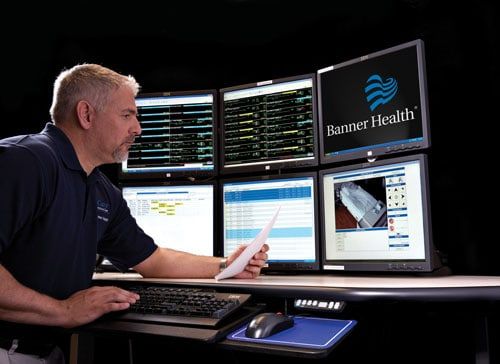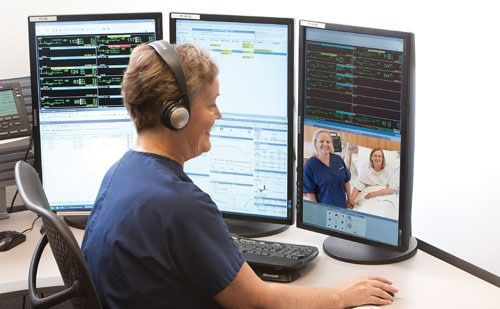Telemedicine: Just what the doctors ordered


Courtesy Dan Vermillion
Until a year ago, Dr. Alan Zacharias’ nights often weren’t his own.
With stroke victims required to see a neurologist before tissue plasminogen activator can be prescribed, he and other Boulder Community Health neurologists were often rushing to the emergency room in the middle of nights, trying to cut vital minutes from their travel time — time that might well save brain function in the patient.
“That time can be very important,” said Zacharias, director of BCH’s neurology clinic. During the last year, the emergency room has been using a tele-, or virtual, medicine program, Blue Sky Neurology, which can connect stroke victims with neurologist in a matter of minutes.
“We’ve been using it for about a year now,” Zacharias said, noting the ER sees at least three to five such situations every week. “We are seeing vastly decreasing times (for treatment). Every moment you increase that time, you increase the risk of irreversible damage.”
Virtual medicine, once thought of mostly as a means of providing service to rural areas, is making an impact across northeastern Colorado health networks. While providing rural services is still an important element in the programs, more and more health networks are looking at tele-medicine as a method of increasing the value of their entire health portfolio — often in different and very distinct fashion.
“We absolutely see this as a strategic direction for our entire health system,” said Peter Kung, system vice president for virtual health at SCL Health, which includes Good Samaritan Medical Center in Lafayette, the Platte Valley Medical Center in Brighton and SCL Health Community Hospital in Westminster. While only at his position for a year and few months, coming from UCLA Health, Kung said adoption of new applications in telemedicine has been fast and furious at SCL.
“The senior leadership is committed to really address this as health care undergoes some fundamental changes. This improves access, affordability and convenience. We believe we can deliver quality health regardless of location. It’s part of the whole thrust of (health care) movement from volume to value.”
SCL began many of its programs in Montana, where drives of two or three hours even to the nearest clinic are not uncommon, but most of those programs are being quickly adopted in Colorado.
“If you are in Brighton, you might be seeing a specialist from our children’s hospital, or a pulmonologist or cardiology expert from St. Joseph’s,” Kung said. “Those specialties would not be available without that modality.”
At Platte Valley, intensive-care patients see specialists from National Jewish Hospital at least twice daily, as doctors making physical rounds are joined by specialists who interact with patients via a robot that drives itself up to bedside for video connectivity, along with vital signs.
“It’s as if in your community, you have the top Denver docs at your bedside,” Kung said.
But the first interaction most of us with have with telemedicine will probably be a lot less dramatic. Almost all the networks are adopting virtual replacements for low-acuity visits to emergency rooms or urgent-care centers.
At SCL that’s a program called Doctors on Demand, physicians that be reached through a smartphone call and interaction. Primarily, it is designed to keep patients who are sick now, but don’t really need urgent care for such ailments as pink eye, and colds and flu. Doctors on Demand charges a flat fee of $49 for such virtual visits, which is a solution available to everyone, regardless of their insurance situation.
In Banner Health’s Western Region — which includes McKee Medical Center in Loveland, Banner Fort Collins Medical Center and North Colorado Medical Center in Greeley — adopting telemedicine came as a consequence of extraordinary efforts already being made to serve rural populations.
John Ward, senior director of outreach services for Banner in Northern Colorado, said the network uses private planes to fly some 100 clinical physicians to clinics in eastern Colorado, southeastern Wyoming and western Kansas as needed. However, those visits, which include 17 physician specialties in 15 communities, are frequently preempted by weather, especially in winter months.
So, as a complement to those services, Banner started offering virtual visits with those same specialists when the flights were canceled. Now patients can choose to still go to their local clinic and visit with their specialist remotely, rather than have to wait as many as three weeks for an in-person visit.
“Typically, these are specialists they are already seeing. The physician can see the patient on one screen while seeing medical records and vital signs on the other,” Ward said. Patient surveys showed an overwhelming appreciation of the programs, prompting Banner to look at advancing them even further.
“Our goal initially was just to reduce our cancelled clinics, but now we are able to support rural primary-care physicians when they want a patient to be seen within a week, rather than a month. We simply block out a half an hour at the (rural) clinic and a half an hour of the specialist’s time,” Ward said.
“I’m really excited to be part of this program at Banner,” he said. “Now we can get rural patients in front of a specialist within a day or two. We can also keep patients and their families from having to take an entire day off work to get in to see a specialist when they really need.”
Banner is ramping up the program in Yuma and Wray, where remote physicians can actually hear their heartbeats by special stethoscopes. Banner also runs the Western Burn Center for six Rocky Mountain States, and specialist there advise emergency-room doctors with the use of smartphone photos.
All of such pipelines of information — including smartphone calls from programs such as Doctors on Demand — have to be secured under HIPAA compliance. That compliance requires some forethought, but doesn’t appear to be standing in the way of increasing use of virtual medicine.
Longmont United Hospital updates continue every day under Centura Health, said Samantha Lippolis, Centura director of telemedicine.
“At Longmont United, we do Telestroke, where you bring a stroke neurologist in via a camera to the emergency room,” she said. But specialty visits from St. Anthony’s North are also available to eight rural clinics across Colorado and western Kansas.
What specialty and telemedicine services are provided depends largely on what the community wants and needs, Lippolis said. Concussion, pulmonology, cardiology and genetic counseling are some of the most commonly supported specialties, but more and more services such as behavioral health and psychiatric services are needed to support ER services, as well.
“Anywhere we can help improve access to services is where we are looking to improve,” said Julie Reisetter, chief nursing officer for Banner Telehealth. “A lot of remote providers have some degree of support for patients — 12 or 13 percent of their beds have this technology. In Banner, 100 percent of our beds are supported by this model.”
At BCH, Dr. Jason Cannell, said beyond the stroke service, the hospital is still pursuing a more-vigorous model, focusing on improving — rather than duplicating — existing diagnostic and condition-management services. Those services will include the low-acuity virtual visits to physicians to help drive down ER and urgent-care visits, which will also probably be done with a flat fee ranging from $49 to $69.
As a smaller network, the focus has been on finding a very good fit with a technological partner, said Cannell, medical director of field operations for BCH.
In the first quarter of next year, BCH will have a pilot program in place, focusing on urgent care and five or 10 providers with an emphasis of serving acute needs.
Meanwhile, there are a few BCH neurologists who are sleeping a lot better.
“It’s a lot better to sleep and then be able to see these patients the next day,” Zacharias said.

Courtesy Dan Vermillion
Until a year ago, Dr. Alan Zacharias’ nights often weren’t his own.
With stroke victims required to see a neurologist before tissue plasminogen activator can be prescribed, he and other Boulder Community Health neurologists were often rushing to the emergency room in the middle of nights, trying to cut vital minutes from their travel time — time that might well save brain…
THIS ARTICLE IS FOR SUBSCRIBERS ONLY
Continue reading for less than $3 per week!
Get a month of award-winning local business news, trends and insights
Access award-winning content today!
